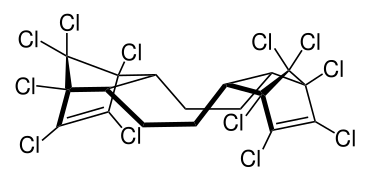Dechlorane plus
Polychlorinated flame retardant From Wikipedia, the free encyclopedia
Dechlorane plus (abbrev. DDC-CO[1]) is a polychlorinated flame retardant produced by Oxychem.
 | |
| Names | |
|---|---|
| IUPAC name
1,2,3,4,7,8,9,10,13,13,14,14-dodecachloro-1,4,4a,5,6,6a,7,10,10a,11,12,12a-dodecahydro-1,4,7,10-dimethanodibenzo[a,e]cyclooctene | |
| Other names
Dechloran A | |
| Identifiers | |
3D model (JSmol) |
|
| ChemSpider | |
| ECHA InfoCard | 100.033.575 |
| EC Number |
|
PubChem CID |
|
| UNII | |
CompTox Dashboard (EPA) |
|
| |
| |
| Properties | |
| C18H12Cl12 | |
| Molar mass | 653.72 g/mol |
| Appearance | white, crystalline solid |
| Density | 1.8 g/cm3 |
| Melting point | 350 °C (662 °F; 623 K) (decomposes) |
| 0.044–249 μg/L | |
Except where otherwise noted, data are given for materials in their standard state (at 25 °C [77 °F], 100 kPa).
| |
It is produced by the Diels-Alder reaction of two equivalents of hexachlorocyclopentadiene with one equivalent of cyclooctadiene. The syn and anti isomer are formed in the approximate ratio of 1:3.[3][4]
- syn isomer
- anti isomer
Environmental concerns
Dechlorane plus was first found in the environment in 2006 in air around the Great Lakes.[5] Since then, its environmental occurrence has been further documented in several studies including sediments of the Great Lakes;[6] zooplankton, fish, and mussels in Lake Winnipeg and Lake Ontario;[7] air and seawater from the Arctic to Antarctica;[8] and Chinese air.[9] In 2011, modeling data indicated that Dechlorane Plus may be persistent, bioaccumulative, and subject to long-range transport.[10] The 2023 Conference of the Parties of the United Nations Stockholm Convention on Persistent Organic Pollutants took the decision to eliminate the use of Dechlorane Plus, by listing this chemical in Annex A to the Convention.[11]
Dechlorane plus was added to the list of REACH Substances of Very High Concern on January 15, 2018.[12]
Literature
- ENVIRON Health Sciences Institute. "Dechlorane Plus High Production Volume (HPV) Chemical Challenge Program Test Plan. 201-15635" (PDF). Archived from the original (PDF) on 2012-10-23.
References
Wikiwand - on
Seamless Wikipedia browsing. On steroids.


